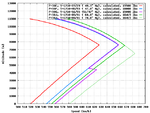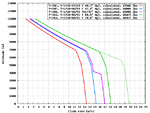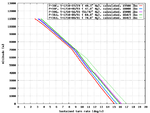Hi everyone,
Here some graphs I prepared for comparing the performance of various P-38 variants.
The graphs are based on the simplified assumption that the turbo-supercharged Allisons did in fact offer constant power from sea level to critical altitude as rated. Test data on Mike's site P-38 Performance Trials shows reality to be far more complex, with P-38 power being limited not only by the boost level, but also by carburettor air temperature and turbo-supercharger speed limitations. However, the results of my simplified assumption still match the real-world data suprisingly well, so I share them here in the hope that you can help me to find more accurate data.
For drag calibration, I have only used two data points:
- The P-38E top speed of 390 mph
- The P-38J top speed of 415 mph
The E, F and G versions are considered to have identical drag so that their speed graphs were calculated from the engine power graphs alone, while the J version has been calibrated to match the above top speed and shows to have significantly increased drag, no doubt due to the much larger radiators.
Of course, the benefit is that the P-38J is able to exploit the available engine power fully without fear of exceeding the carburettor air temperature limit. The "funny" shape of the P-38G graphs is due to the pilot having to reduce boost from 51" Hg to 47" Hg to stay clear of the above limit, showing the limitations of the earlier models with smaller radiators.
Generally, the engine charts are generically derived from the relevant Specific Engine Flight Charts for the type, listing boost level, critical altitude and power of each type's engines. In the case of the P-38G, only the 51" Hg are listed, so the 47" Hg are my educated guess of what the pilot could use after reducing boost from the full war emergency rating. (Actually, I simply used the boost setting of the P-38F.)
You will see that the P-38 does not show up as a particularly good turner, which is somewhat of a surprise seeing the praise the type usually gets for its combat flaps. The turn calculation is based on the Clmax figure of 1.15 derived from NACA TN-1044, which lists this as maximum for the P-38F. While it does not include the use of combat flaps, the P-38 turn rate appears to be limited more by the available power than by the available lift, though turn radius would undoubtly benefit from combat flaps. That the P-38 left to be desired in terms of turning ability even according to the contemporary USAAF evaluators is evident from some of the reports at P-38 Performance Trials though.
If you have more information on the P-38's turning ability that might help to improve my analysis, you're invited to share it!
Regards,
Henning (HoHun)
Here some graphs I prepared for comparing the performance of various P-38 variants.
The graphs are based on the simplified assumption that the turbo-supercharged Allisons did in fact offer constant power from sea level to critical altitude as rated. Test data on Mike's site P-38 Performance Trials shows reality to be far more complex, with P-38 power being limited not only by the boost level, but also by carburettor air temperature and turbo-supercharger speed limitations. However, the results of my simplified assumption still match the real-world data suprisingly well, so I share them here in the hope that you can help me to find more accurate data.
For drag calibration, I have only used two data points:
- The P-38E top speed of 390 mph
- The P-38J top speed of 415 mph
The E, F and G versions are considered to have identical drag so that their speed graphs were calculated from the engine power graphs alone, while the J version has been calibrated to match the above top speed and shows to have significantly increased drag, no doubt due to the much larger radiators.
Of course, the benefit is that the P-38J is able to exploit the available engine power fully without fear of exceeding the carburettor air temperature limit. The "funny" shape of the P-38G graphs is due to the pilot having to reduce boost from 51" Hg to 47" Hg to stay clear of the above limit, showing the limitations of the earlier models with smaller radiators.
Generally, the engine charts are generically derived from the relevant Specific Engine Flight Charts for the type, listing boost level, critical altitude and power of each type's engines. In the case of the P-38G, only the 51" Hg are listed, so the 47" Hg are my educated guess of what the pilot could use after reducing boost from the full war emergency rating. (Actually, I simply used the boost setting of the P-38F.)
You will see that the P-38 does not show up as a particularly good turner, which is somewhat of a surprise seeing the praise the type usually gets for its combat flaps. The turn calculation is based on the Clmax figure of 1.15 derived from NACA TN-1044, which lists this as maximum for the P-38F. While it does not include the use of combat flaps, the P-38 turn rate appears to be limited more by the available power than by the available lift, though turn radius would undoubtly benefit from combat flaps. That the P-38 left to be desired in terms of turning ability even according to the contemporary USAAF evaluators is evident from some of the reports at P-38 Performance Trials though.
If you have more information on the P-38's turning ability that might help to improve my analysis, you're invited to share it!
Regards,
Henning (HoHun)



